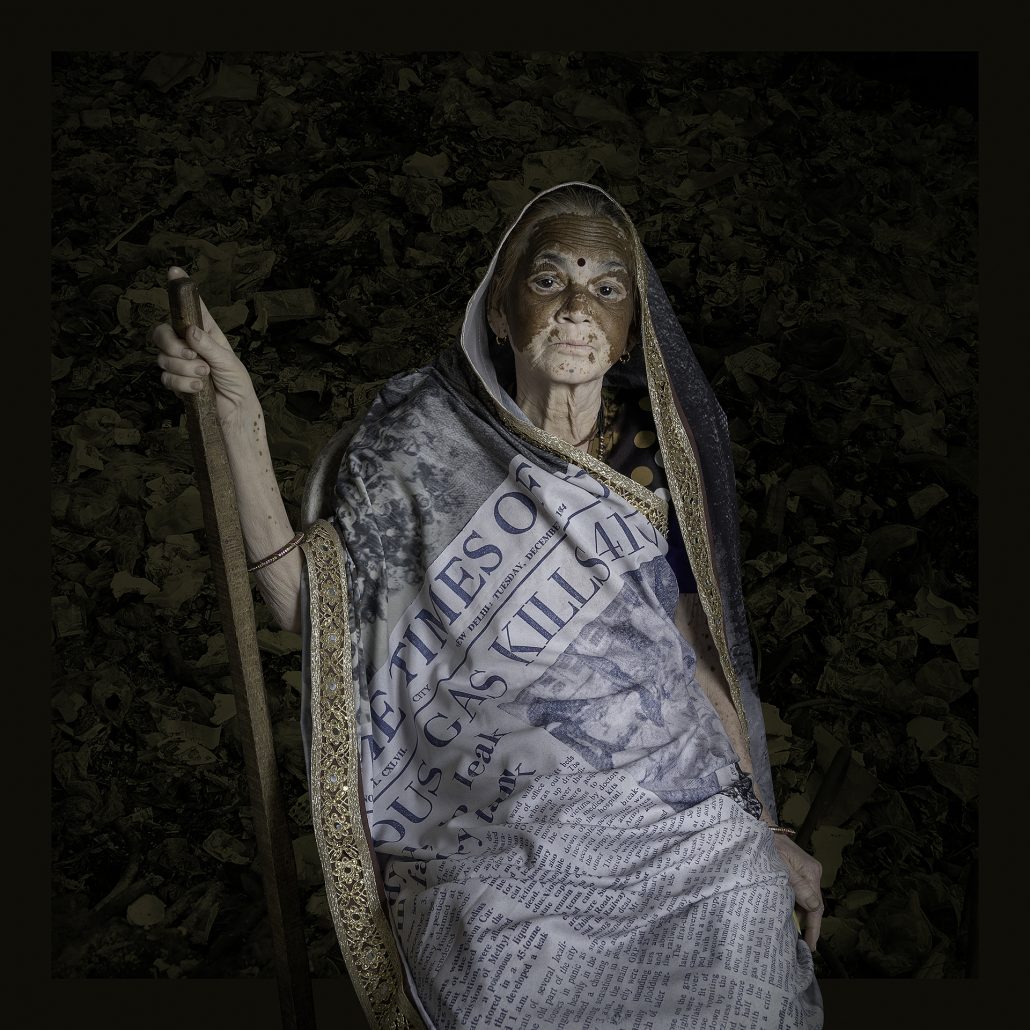India
This post is also available in:
 French
French
Bhopal is like a tattoo on their skin. Should I really have given them these saris, printed with press cuttings reporting on that night in December 1984 when a lethal gas escaped from the Union Carbide chemical plant, spreading stealthily through the town, or printed with X-rays of victims where you can see the silent injuries, leaving their bodies exhausted, or printed with the skeleton of the factory standing immobile like a statue, or printed with views of the surroundings, where, absurdly, families were out enjoying picnics as if nothing had happened ? They laid them out, chose amongst them, put them on and looked at me, or preferred to show me just their backs, simple silhouettes like a frozen image.
I photographed the town, the interiors of the houses where life went on because it had to, and the patients in clinics where they try to treat what can be treated. I went back into what it is left of the factory. I rummaged through archives, found the warning letters dated from before the explosion, I heard the cries of anger and the resigned silence. I took my time. And I got to like these women standing tall.
They accepted to wear Bhopal on their skin. They are seeking compensation for the 3500 deaths on the night of the catastrophy and for the 200 000 more that were added as the years went by. They protest in the streets demanding that the authorities clean up the site which continues to pollute the area. They suffer too, but don’t complain because life has to go on. The coloured embroidery on the hem of the saris underscores the fact that they are still women. Even inside the most modest homes I could see that delicate touch which is also a silent battle. These images remind us of what Bhopal was and what this Indian town is today, whose name will forever be associated with a chemical catastrophy which could have been avoided.
So yes, I was right to have given them the saris. Wearing them is a gesture of defiance and I’m delighted that they look well for the fight.
2019 marks the 35th anniversary of the catastrophy. It continues to kill and the number of victims continues to rise, even though it is hardly ever in the news any more.
Isabeau de Rouffignac
LOS SARIS DE LA MEMORIA
Isabeau de Rouffignac
India, 2017-2018
Bhopal, como una segunda piel. Solo dispuse ante ellas esos saris impresos con recortes de prensa que ilustran la historia de aquella tremenda noche de diciembre de 1984 – cuando un gas mortal se escapó de la planta química de Union Carbide inundando la ciudad – con imágenes médicas donde se adivinan los estragos silenciosos que dejan los cuerpos exhaustos, el esqueleto de esa fábrica como una estatua inerte, las vistas de los alrededores, donde, desafiando lo impensable, las familias van aún de picnic como si nada hubiera ocurrido. La reacción primera de estas mujeres fue desplegarlos, luego se los apropiaron, se cubrieron con ellos y me miraron o prefirieron ofrecerme sus espaldas, como una silueta inmóvil.
Fotografié la ciudad, los interiores de las casas donde la vida continuó porque el tiempo no se detiene, los pacientes en esas clínicas donde se trata de curar lo que aún se puede reparar. Volví a lo que quedaba de la fábrica. Busqué en los archivos, encontré las cartas de alerta, antes de que Bhopal cambiara, oí gritos de enojo y silencios resignados. Me tomé el tiempo. Y admiré a todas esas mujeres de pie.
Aceptaron que Bhopal se pegase aún más a su piel. Ellas solo reclaman justicia y compensación por las 3.500 muertes directas en la noche del desastre y los 200.000 pacientes que se han añadido a lo largo de los años. Salen a la calle para exigir a las autoridades que descontaminen el lugar, que hoy sigue siendo tóxico. Ellas sufren, pero no dicen mucho ya que saben que hay que avanzar. Siguen siendo mujeres y eso es también lo que dicen estos bordados de colores que adornan los saris. Incluso en los interiores más modestos, he visto esta delicadeza, que es también una lucha silenciosa. Estas imágenes nos recuerdan lo que fue Bhopal y lo que es hoy esta ciudad india, cuyo nombre está definitivamente vinculado a un desastre de la industria química que podría haber sido evitado.
Entonces sí, tuve razón de disponer estos saris antes estas mujeres. Los llevan hoy como un reto y me gusta que sean bellas en esta lucha.
En el 2019 se cumplen 35 años desde que ocurrió esta catástrofe. Inmensa en cantidad de víctimas, pero apenas mencionada, hoy continúa matando lentamente.



